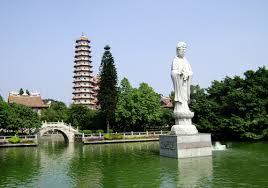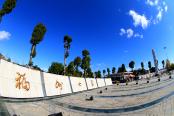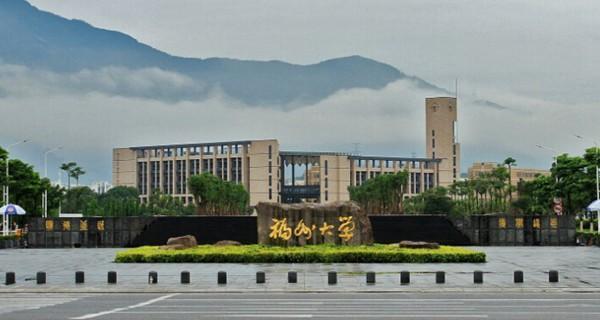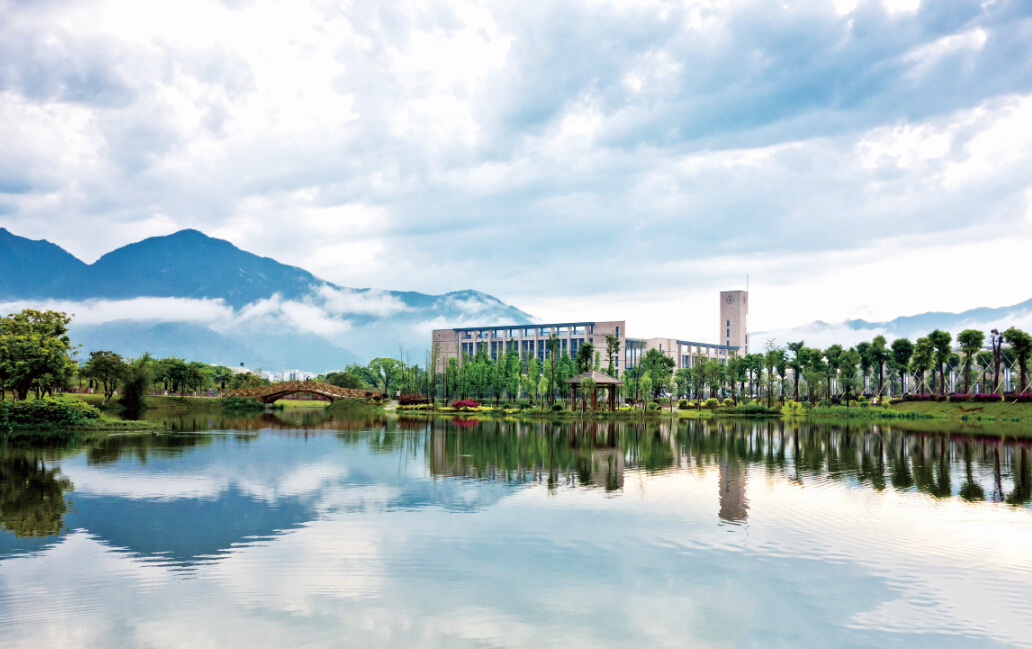11. Regarding Fuzhou City and Fuzhou University
 REGARDING LOCAL HOST
REGARDING LOCAL HOST
![]() Fuzhou City
Fuzhou City

Fuzhou is the capital city of Fujian Province, located on China’s southeastern coast. With along tradition as a coastal port and shipbuilding center, Fuzhou is the major coastal city between Hong Kong and Shanghai. It is known as “Banyan Town” after the subtropical banyan trees planted there since the Song dynasty. As the central city of a province with many ethnic and linguistic links to Taiwan, Fuzhou has benefited from cross-strait investment and is today a major commercial and manufacturing center.
 Fuzhou lies on the Min River, in the east of Fujian Province, some 50 km (30 miles) from the sea. The city is on a subtropical plain close to the Fu Mountains. It is 700 km (435 miles) northeast of Hong Kong, and 1,500 km (930 miles) southeast of Beijing.
Fuzhou lies on the Min River, in the east of Fujian Province, some 50 km (30 miles) from the sea. The city is on a subtropical plain close to the Fu Mountains. It is 700 km (435 miles) northeast of Hong Kong, and 1,500 km (930 miles) southeast of Beijing.
Fuzhou’s history dates back to the 3rd century AD, when it became a center of ore smelting. Thereafter it was capital, known as Minzhou, of the coastal kingdom of Minyue. When it was absorbed into the Tang dynasty, Fuzhou acquired its present name, which mean “prosperous city” or “fortunate city.” It grew wealthy as a coastal port for the export of tea.

Marco Polo is supposed to have passed through Fuzhou at the end of the 13th century. He described it as a great center of international commerce with special links to the Indian trade, prosperous, with great gardens and an abundance of fruit. He also noted the presence of a large Christian community there, with roots going back several hundred years. These were possibly descendants of Nestorian Christians, a Syrian sect that had come to China via the Silk Road.
 Fuzhou’s international links continued in the Ming dynasty, when it was the homeport for the international voyages of the eunuch-admiral Zheng He in the early 15th century. In 1842, following the Opium Wars, Fuzhou became one of the five ports declared open to foreign trade. It also became a center of both Catholic and Protestant missionary activity after that time.
Fuzhou’s international links continued in the Ming dynasty, when it was the homeport for the international voyages of the eunuch-admiral Zheng He in the early 15th century. In 1842, following the Opium Wars, Fuzhou became one of the five ports declared open to foreign trade. It also became a center of both Catholic and Protestant missionary activity after that time.
Because of Fuzhou’s proximity to Taiwan, and the ethnic and linguistic closeness of the two regions, cross-strait investment has made Fuzhou one of China’s most prosperous cities. (Reference: http://www.chinatoday.com/city/fuzhou.htm)
![]() Fuzhou University
Fuzhou University

Founded in 1958, Fuzhou University is one of the national key universities that are selected into the “211 Project”, a Chinese government programme for the 21st century to support 100 selected universities for their further rapid development. Since its establishment, Fuzhou University has developed into a key comprehensive university in Fujian Province, giving priority to engineering courses and also enjoying a reputation for excellence in other fields including sciences, economics, management, liberal arts, law, arts and design, etc.
 Now Fuzhou University covers more than 333 hectares, including several campuses such as Yishan campus, Qishan campus, Tongpan campus and the Academy of Arts and Design in Xiamen. The main running campus is located in Qishan campus of the University Town of Fuzhou Region. There are 19 schools in Fuzhou University mainly for undergraduate education and two independently operated colleges—Zhicheng College and Yangguang College. There are 4 post-doctoral research stations, 9 doctoral degree programmes for the first-rank disciplines, 54 doctoral degree programmes for the second-rank disciplines, 29 master’s degree programmes for the first-rank disciplines and 168 master’s degree programmes for the second-rank disciplines and 11 professional degree authorization stations.
Now Fuzhou University covers more than 333 hectares, including several campuses such as Yishan campus, Qishan campus, Tongpan campus and the Academy of Arts and Design in Xiamen. The main running campus is located in Qishan campus of the University Town of Fuzhou Region. There are 19 schools in Fuzhou University mainly for undergraduate education and two independently operated colleges—Zhicheng College and Yangguang College. There are 4 post-doctoral research stations, 9 doctoral degree programmes for the first-rank disciplines, 54 doctoral degree programmes for the second-rank disciplines, 29 master’s degree programmes for the first-rank disciplines and 168 master’s degree programmes for the second-rank disciplines and 11 professional degree authorization stations.
 Fuzhou University has been approved by the Ministry of Education to offer undergraduate and postgraduate programmes to students from Hong Kong, Macao, Taiwan regions and foreign countries. At present, there are about 50,000 students in Fuzhou University, including about over 5,200 doctoral and master's degree seekers. Since its establishment, about 200,000 students graduated from Fuzhou University, including full-time doctoral and master's degree students as well as those with the bachelor's degrees and associate degrees. (Reference: Wiki Fuzhou University)
Fuzhou University has been approved by the Ministry of Education to offer undergraduate and postgraduate programmes to students from Hong Kong, Macao, Taiwan regions and foreign countries. At present, there are about 50,000 students in Fuzhou University, including about over 5,200 doctoral and master's degree seekers. Since its establishment, about 200,000 students graduated from Fuzhou University, including full-time doctoral and master's degree students as well as those with the bachelor's degrees and associate degrees. (Reference: Wiki Fuzhou University)
 The School of Economics and Management at Fuzhou University has been growing fast along with the reform, opening-up and rapid development of China in the changing global economic environment. The school offers two major categories of disciplines: Management and Economics. It has two post-doctoral mobile stations: Management Science and Engineering, and Business Administration. There are 2 first-level disciplines with doctor’s degree programs, including Management Science and Engineering, and Business Administration. There are 13 second-level disciplines offering doctor’s degree programs, namely, Technical Economics and Management, Management System Engineering, Science and Technology and Education Management, Information Management and Information System, Logistics Management, Financial Engineering, Accounting, Corporate Management, Tourism Management, Corporate Finance and Financial Innovation, Economics and Industry System Management, Electronic Administration Affairs and Regional Resource Management, Policy Science and Government Administration Innovation.
The School of Economics and Management at Fuzhou University has been growing fast along with the reform, opening-up and rapid development of China in the changing global economic environment. The school offers two major categories of disciplines: Management and Economics. It has two post-doctoral mobile stations: Management Science and Engineering, and Business Administration. There are 2 first-level disciplines with doctor’s degree programs, including Management Science and Engineering, and Business Administration. There are 13 second-level disciplines offering doctor’s degree programs, namely, Technical Economics and Management, Management System Engineering, Science and Technology and Education Management, Information Management and Information System, Logistics Management, Financial Engineering, Accounting, Corporate Management, Tourism Management, Corporate Finance and Financial Innovation, Economics and Industry System Management, Electronic Administration Affairs and Regional Resource Management, Policy Science and Government Administration Innovation.

There are 6 master’s degree programs under the first-level disciplines and 23 academic and 10 professional master’s degree programs under the second-level disciplines. There is a national “211 Project” Key Disciplinary Construction Project--- Management Science Theories, Methods and Applications, a provincial key discipline --- Management Science and Engineering with Distinctive Characteristics, and 4 provincial key disciplines, namely Management Science and Engineering, Business Administration, Applied Economics, and Public Administration.

The school has strong teaching faculty with reasonable organizational structure and there are quite a few vigorous and innovative experts and scholars who enjoy high reputation at home and abroad with their profound academic achievements. The school comprises 277 faculty members, including 208 full-time teachers and researchers, among whom there are 50 professors, 94 associate professors, and 24 doctorate supervisors.
